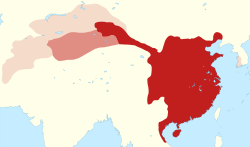Tang dynasty
The Tang dynasty (Chinese: 唐朝; pinyin: Tángcháo) (June 18, 618 – June 4, 907) was an imperial dynasty of China.
Tang 唐 | |||||||||||||||||||||||||
|---|---|---|---|---|---|---|---|---|---|---|---|---|---|---|---|---|---|---|---|---|---|---|---|---|---|
| |||||||||||||||||||||||||
 Tang dynasty c. 669. Map of China during the Tang Dynasty. | |||||||||||||||||||||||||
| Capital | |||||||||||||||||||||||||
| Common languages | Middle Chinese | ||||||||||||||||||||||||
| Religion | |||||||||||||||||||||||||
| Government | Monarchy | ||||||||||||||||||||||||
| Emperor | |||||||||||||||||||||||||
• 618–626 (first) | Emperor Gaozu | ||||||||||||||||||||||||
• 626–649 | Emperor Taizong | ||||||||||||||||||||||||
• 712–756 | Emperor Xuanzong | ||||||||||||||||||||||||
• 904–907 (last) | Emperor Ai | ||||||||||||||||||||||||
| History | |||||||||||||||||||||||||
| June 18, 618 | |||||||||||||||||||||||||
• Usurped by Wu Zetian | 690–705a | ||||||||||||||||||||||||
• An Lushan Rebellion, also called the An–Shi Rebellion Traditional Chinese: 安史之亂) | 755–763b | ||||||||||||||||||||||||
• Abdication in favour of the Later Liang (Traditional Chinese: 後梁) | June 1, 907 | ||||||||||||||||||||||||
| Area | |||||||||||||||||||||||||
| 715[1][2] | 5,400,000 km2 (2,100,000 sq mi) | ||||||||||||||||||||||||
| Population | |||||||||||||||||||||||||
• 7th century | 50 million | ||||||||||||||||||||||||
• 9th century | 80 million | ||||||||||||||||||||||||
| Currency | |||||||||||||||||||||||||
| |||||||||||||||||||||||||
a October 8, 690 – March 3, 705. b December 16, 755 – February 17, 763. | |||||||||||||||||||||||||
| Tang dynasty | |||||||||||||||||||||||||||||||||
"Tang dynasty" in Traditional Chinese characters | |||||||||||||||||||||||||||||||||
| Chinese | 唐朝 | ||||||||||||||||||||||||||||||||
|---|---|---|---|---|---|---|---|---|---|---|---|---|---|---|---|---|---|---|---|---|---|---|---|---|---|---|---|---|---|---|---|---|---|
| |||||||||||||||||||||||||||||||||
History
changeThe Tang Dynasty came after the Sui Dynasty (隋) and was followed by the Five Dynasties and Ten Kingdoms Period (Traditional Chinese: 五代十國). It was founded by the Li (李) family, who came to power during the fall of the Sui Dynasty. The dynasty was interrupted briefly by the Wu Zhou (Traditional Chinese: 武周) usurper regime,[3] (October 16, 690 – March 3, 705) founded by Empress Wu Zetian (Traditional Chinese: 武則天) who managed to claim the throne, becoming the first and only Chinese Empress.
The Tang Dynasty, with its capital at Chang'an (Traditional Chinese: 長安) in present-day Xi'an (Traditional Chinese: 西安), was the biggest city in the world at the time. It is considered by historians as a high point in Chinese civilization – maybe even greater than the earlier Han Dynasty (Traditional Chinese: 漢朝) – as well as a golden age of cosmopolitan culture. Empress Wu, the first woman to ever rule in China, was also included in the Tang Dynasty. Her ruling methods were sometimes vicious, but she was very talented and intelligent.[source?]
Related pages
changeOther websites
change- The Tang Dynasty at the Metropolitan Museum of Art
- Home of 300 Tang Poems, University of Virginia
- The Tang Dynasty Archived 2011-07-07 at the Wayback Machine at AsianSpiritGallery
References
change- ↑ Turchin, Peter; Adams, Jonathan M.; Hall, Thomas D (December 2006). "East-West Orientation of Historical Empires". Journal of World-systems Research. 12 (2): 222. ISSN 1076-156X.
- ↑ Taagepera, Rein (1997). "Expansion and Contraction Patterns of Large Polities: Context for Russia". International Studies Quarterly. 41 (3): 475–504. doi:10.1111/0020-8833.00053. JSTOR 2600793. p. 492.
- ↑ which should be clearly distinguished from the Zhou Dynasty (Traditional Chinese: 周朝), which lasted from c. 1046 BC to 256 BC for 789 years during the classical antiquity.